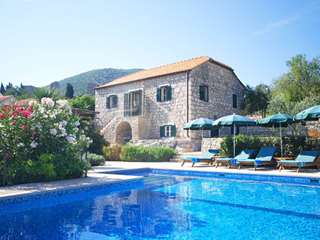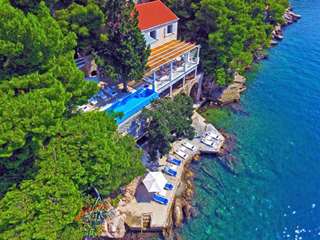Dubrovnik Region travel guide
- Discover Dubrovnik - pearl of the Adriatic
- Airports: Dubrovnik. 2 ½ hours from London
- Mljet National Park
- Wine tasting on the Peljesac peninsula
- Music and culture - Dubrovnik summer festival
- Must see: view from the cable car above Dubrovnik
This region encompasses the mainland coast and islands of southern Dalmatia including Korcula town and Croatia's greenest island, Mljet
Dubrovnik is the focal point of the region. It is a UNESCO world heritage site and offers a fascinating history, stunning Venetian architecture, wonderful streets, town squares and alleyways in which to stroll and stop to enjoy a meal or a coffee, museums and cultural events, a fine choice of restaurants and a vibrant nightlife, all within a setting of exceptional beauty. The city is dominated by its great walls and fortifications which incorporate several large castles. The walls are open to the public and a walk around them is an essential element of any trip to
Dubrovnik. The view from the high wall above the town, over the red tiled rooftops of the ancient city and beyond to the blue Adriatic sea and the green island of Lokrum is an unforgettable image.
Dubrovnik today extends well beyond the old town and incorporates Gruz, a large natural harbour where cruise ships and large yachts tie up at the quays. The Dubrovnik noblemen of the 16th and 17th centuries built their summer palaces on the shores of Gruz harbour and today these wonderful building form a part of a busy commercial centre with shops and markets.
From Dubrovnik ferry services run to the islands of
Sipan,
Lopud and
Kolocep which will charm you with their unspoilt and authentic atmosphere of the slow pace of the Mediterranean life, incredibly lovely fishermen’s cottages and again the summer palaces which the Dubrovnik nobles built for themselves to enjoy cooler summers in their gardens by the sea.
Travelling south east from Dubrovnik on the mainland you will encounter the lovely villages of
Mlini, Plat,
Molunat and others, each with their stone cottages, luxury villas and lovely beaches. The small town of
Cavtat, set in a sheltered bay, is particularly beautiful. All are popular tourist destinations.
Going north westwards, a magnificent coastal road takes you past the arboretum and, Mediterranean garden of the historic villa of Trsteno built between 1494 and 1502. Continuing along the coast road will take you to the
peninsula of Peljesac. This long and rugged peninsula runs parallel to the mainland for 65 kilometres and is between 2 and 7 kilometres wide. It joined to the mainland by a narrow isthmus at its south east end. The Dubrovnik Republic acquired control over
Peljesac in 1333 and proceeded to construct massive fortifications in the form of a 5.5 kilometre wall spanning the isthmus and circling the towns of
Ston and Mali Ston that were constructed on the coast at either end of the wall. These are historic and picturesque fortified towns that were laid to a grid plan similar to Dubrovnik in the 14th and 15th centuries and today are immensely picturesque and famed for their restaurants and the local oysters. From Prapratno (near
Ston) a ferry runs to the island of
Mljet, the most wooded of Croatia’s 1100 islands.
Mljet is 30km long and only 3km wide. One third of the island is a national park that contains two lakes that are linked to each other and to the sea. In the centre of the large lake is an island with a Benedictine monastery first established in the 12th century and rebuilt in the Renaissance period. There are several excellent seafood restaurants in the village of Polace.
As you proceed up the
Peljesac peninsula the many wineries add a further dimension to a visit to this region. Most are open to the public so you can stop and sample the highly regarded Dingac and Mali Plavac red wines. The pretty seaside villages of Zulijana, and
Trpanj (also a ferry port for a shortcut back to the mainland), and the town of Orebic are charming. The latter with its famous captains’ houses is an important historic town and also the crossing point to the
island of Korcula.
Korcula town is one of the most picturesque Venetian island towns and the birth place of Marco Polo.
On the mainland itself after crossing a short stretch of Bosnia that extends all the way to the coast you re-enter Croatia to find a changed landscape. The coast road winds down into the lush green
Neretva Delta where fresh oranges and other produce are sold from the road side. Continuing northwest the Makarska Riviera is a popular holiday destination and a crossing point to the island of Brac.
 Villa Mimosa
Ston and Mali Ston, Dubrovnik Region
Gorgeous stone villa full of charm and character in one of the prettiest places, only 30 seconds to the beach
3 Bedrooms / Sleeps: 6 + 2
from 1200 € / week
Villa Mimosa
Ston and Mali Ston, Dubrovnik Region
Gorgeous stone villa full of charm and character in one of the prettiest places, only 30 seconds to the beach
3 Bedrooms / Sleeps: 6 + 2
from 1200 € / week
 Villa Estella
Klek, Dubrovnik Region
Large, secluded villa with heated pool, tennis, wine cellar, Mediterranean garden – what a view!
5 Bedrooms / Sleeps: 12 + 3
from 2541 € / week
Villa Estella
Klek, Dubrovnik Region
Large, secluded villa with heated pool, tennis, wine cellar, Mediterranean garden – what a view!
5 Bedrooms / Sleeps: 12 + 3
from 2541 € / week
 Villa Libertas
near Dubrovnik, Dubrovnik Region
Magnificent Dubrovnik villa with stylish interior, terraces, steps to a private pool and seafront
4 Bedrooms / Sleeps: 7
from 4200 € / week
Villa Libertas
near Dubrovnik, Dubrovnik Region
Magnificent Dubrovnik villa with stylish interior, terraces, steps to a private pool and seafront
4 Bedrooms / Sleeps: 7
from 4200 € / week
 Spirit of Dubrovnik
Dubrovnik, Dubrovnik Region
Grandeur, luxury, classical elegant villa, pool, charming garden with sea views near Old Dubrovnik
7 Bedrooms / Sleeps: 14 + 2
from 10850 € / week
Spirit of Dubrovnik
Dubrovnik, Dubrovnik Region
Grandeur, luxury, classical elegant villa, pool, charming garden with sea views near Old Dubrovnik
7 Bedrooms / Sleeps: 14 + 2
from 10850 € / week
 Villa Amana
near Dubrovnik, Dubrovnik Region
Superb marvelous, modern seafront villa with stunning sea views and private pool in and elite Duborvnik suburb reach the busy Dubrovnik Old Town in no time!
3 Bedrooms / Sleeps: 6
from 2142 € / week
Villa Amana
near Dubrovnik, Dubrovnik Region
Superb marvelous, modern seafront villa with stunning sea views and private pool in and elite Duborvnik suburb reach the busy Dubrovnik Old Town in no time!
3 Bedrooms / Sleeps: 6
from 2142 € / week
 Sunshine Beach Villa
Klek, Dubrovnik Region
Secluded cottage right by the beach and sea, set in a vineyard and olive groves.
2 Bedrooms / Sleeps: 4 + 2
from 2275 € / week
Sunshine Beach Villa
Klek, Dubrovnik Region
Secluded cottage right by the beach and sea, set in a vineyard and olive groves.
2 Bedrooms / Sleeps: 4 + 2
from 2275 € / week
 Villa Absolute Dubrovnik
Dubrovnik, Dubrovnik Region
Modern and stunning luxury find in central Dubrovnik with a heated pool
5 Bedrooms / Sleeps: 10
from 4200 € / week
Villa Absolute Dubrovnik
Dubrovnik, Dubrovnik Region
Modern and stunning luxury find in central Dubrovnik with a heated pool
5 Bedrooms / Sleeps: 10
from 4200 € / week
